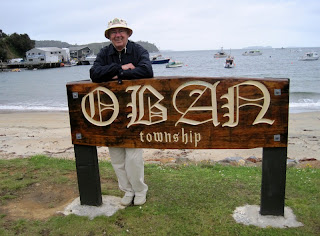 |
| Choir singing to greet us in port |
We began our day by taking the shuttle bus into downtown Wellington. We boarded the Kelburn Cable Car and although the ride is only 6 minutes long it affords a beautiful scenic view of Wellington, the New Zealand capital. The sleek red car caries you up a sheer grade through Mount Victoria to the elevated Kelburn District. We walked down to Wellington through the Wellington Botanic Gardens and the fragrant Lady Norwood Rose Gardens and the Begonia House.
We walked past the Parliament Buildings (the distinctive “Beehive” and the impressive Old Government Building which is the second largest wooden building in the world. We walked down to the harbour to the Museum of wellington City and Sea. The museum is housed in the Bond Store, a listed Category l historic building - important in Wellington’s wharf heritage. This museum houses 800 years of Wellington is New Zealand’s capital. Nestled between the sea and the Tararua Ranges which tower almost 3,000 feet, it stands at the southwestern tip of North Island on Cook Strait, the passage that separates the North and South Islands. Coloured roofs cascade down the steep hillsides, creating a vibrant collage against a spectacular green backdrop. An old brick monastery peers down on a jigsaw of masts and sails in the marina. Port Nicholson is surely one of the finest natural anchorages in the world. Known to local Maori as The Great Harbor of Tara, its two massive arms form the “jaws of the fish of Maui”.
The port of Wellington is entered through a passage eight cables wide after which you enter Wellington Harbour, a bay that is four miles wide and deep, with Somes Island in the middle of it. Wellington is situated on the western side of the bay. Wellington is the southernmost national capital city of the world, with a latitude of about 41 degrees south. It is more densely populated than most other settlements in New Zealand, due to the small amount of building space available between the harbour and the surrounding hills. Because of its location in the roaring forties and its exposure to omnipresent winds coming Wellington’s maitime history: the sinking of the Wahine inter-island ferry is part of it. While we were visiting a lady that was on this ferry when it sank in 1968 was addressing a group of teenage school girls.
We continued walking along the harbour to the Te Papa Tongarewa Museum of New Zealand which means “a container of treasures”. It provides a good introduction to the country’s people, cultures, landforms, flora, fauna.
You don’t need a car to see the city. Civic Square is the heart of town. Lambton Quay is part of a waterfront constructed on land reclaimed from the waters of Port Nicholson and, with Willis Street and Cuba Street, forms a bustling shopping area. Norfolk pines line the broad sweep of Oriental Bay, a suburb with a small beach and a wide promenade.
Ship docked at Aotea Quay between Inter Island ferry and train station.























